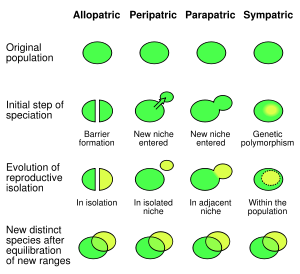From both a medical and a scientific viewpoint, the evolution of viruses is extremely important to us; viral adaptation to their ever changing environment is responsible for major morbidity and mortality worldwide so maybe studying this may allow us to predict virus evolution in the future and may help prevent pandemics occuring?
We kind of know a lot about how viruses evolve at the small-scale; we know how viruses generally create genetic diversity - mutations - and how processes such as natural selection and genetic drift act on these genetic changes and influence the way viral genomes change over time. What we don't know however, is how viruses change at the larger-scale - how these above processes influence viral genomes over thousands of years, including: how and why viruses speciate, how their genome structure evolves and how and when do new viruses originate.
[caption id="" align="aligncenter" width="375" caption="An example phylogenetic tree - The paramyxoviridae containing a number of important human and animal pathogens. Notice the host/viral species distribution."]
 [/caption]
[/caption]A recent study, investigating the evolution of a number of RNA viruses has sought to reconcile this lack of understanding by attempting to assess virus 'macroevolution'- specifically viral speciation. By generating large and highly robust phylogenetic trees (using significantly highly conserved amino-acid sequences of a single viral protein) for 5 genera of RNA virus including: the Alphaviruses, Caliciviruses, Paramyxoviruses, Rhabdoviruses and the Flaviviruses, the team were able to map the host species of each virus species onto the trees and this allowed them to infer the mode of speciation of each virus genus.
More specifically they asked: Do closely related viral species infect the same host and are therefore believed to have speciated in that host or do they infect completely different hosts which are believed to have speciated following host jumping?
What is a virus species?
[caption id="" align="aligncenter" width="300" caption="General modes of speciation - we may think of viruses speciating by either allopatric (host shift) or sympatric (intra-host divergence)."]
 [/caption]
[/caption]The concept of the viral species has been a hard one to determine becuase viruses don't reproduce sexually. It is generally thought to be rather a arbitrary classification, however, most virus 'species' tend to be phylogenetically and often phenotypically stable genetic lineages and hence may be thought of as 'biological relevant'. We may think of viral speciation much like we think of speciation in the classic sense: allopatric or 'geographical speciation' (virus adaptation to a new host species) and sympatric - that not requiring the forces of georgaphic isolation (generation of viral speciation within a single host). Virus sympatric speciation requires the adapation to a new infectious niche within a host, for example a new lineage may infect new cell types within that host. Virus allopatric speciation requires host-jumping or adaptation to a new host altogether but may result from co-divergence follwoing host speciation. Both processes may result in two or more 'stable, phylogenetic and phenotypic genetic lineages. But what does the data say about it - how do viruses evolve in the real world?
What the data says
The results were split - at leats 50% were found to have 'speciated' via sympatric-like processes and half from allopatric-like processes. The group stress, however, that a major caveat of this study is that it highlights our limited understanding of what specific host speces particular viruses infect; in this study most hosts were classified as 'birds' or 'plants' or 'Carnivores' which limits the resolution of phylogenetic studies and leads to the overestimation of sympatric speciation events which would otherwise not exist if exact hosts were known. This leads us to put little confidence on our earlier 50/50 estimate and most likely the role of sympatric speciation would be a lot less important than allopatric modes of speciation in reality.
Why do RNA viruses evolve this way - What controls viral speciation?
So, we may say that most RNA virus speciation is caused by allopatric modes - or host jumping, but this may seem counterintuitive as there are some major barriers to viral emergence. The group argue, however, that it may take a lot more - genetically speaking - for a virus to speciate within a host than it does for a virus to jump species - eg. replicate in a new cell type/alter antigenic epitopes. The apparant preference for allopatric speciation may be controlled by intrinsic biological factors of these RNA viruses, namely: their extremely small genome size which effectively constrains evolutionary innovation. Those changes required for host jumping (change in receptor binding sites for instance) may be relatively minor when compared to those and the more closely related the host species are then the more easily host-jumping will occur - which is what we see here.
This study highlights the key role that viral 'allopatric' speciation or host - jumping plays in the evolution of RNA viruses yet further emphasizes the need to better study and understand viral biodiversity and host range in the wild - not only focusing on those medically important human viruses. Further research may be carried out on the molecular barriers to both cellular and host switching for these RNA viruses. This study will act as a model system that may be applied to other viral lineages - what about the RNA viruses with segmented genomes? What about the DNA viruses? Retroviruses?
Kitchen A, Shackelton LA, & Holmes EC (2011). Family level phylogenies reveal modes of macroevolution in RNA viruses. Proceedings of the National Academy of Sciences of the United States of America, 108 (1), 238-43 PMID: 21173251

















[...] by which mutations arise during replication which are the substrates of natural selection. But how do viruses change on a larger scale – over thousands of years – and how and when do new viruses [...]
ReplyDelete